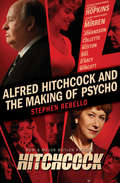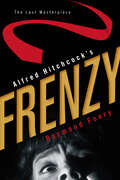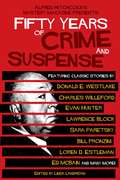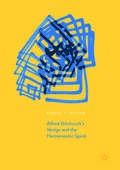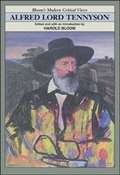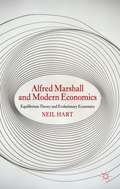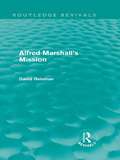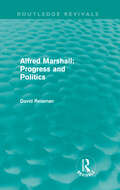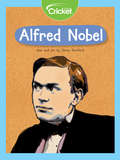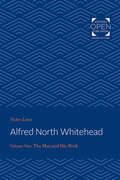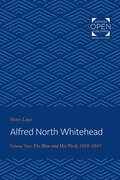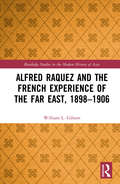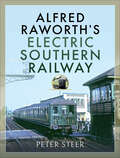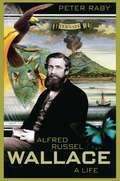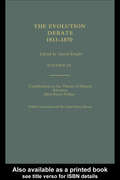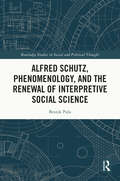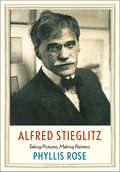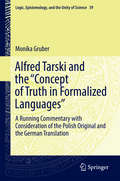- Table View
- List View
Alfred Hitchcock and the Making of Psycho
by Stephen RebelloA &“meticulous history&” of the classic suspense film based on exclusive interviews with the director, writers, cast, and crew (The New York Times Book Review).First released in June 1960, Psycho altered the landscape of horror films forever. But just as compelling as the movie itself is the story behind it, which has been adapted as a movie starring Anthony Hopkins as Hitchcock, Helen Mirren as his wife Alma Reville, and Scarlett Johansson as Janet Leigh. Stephen Rebello brings to life the creation of one of Hollywood&’s most iconic films, from the story of Wisconsin murderer Ed Gein, the real-life inspiration for the character of Norman Bates, to Hitchcock&’s groundbreaking achievements in cinematography, sound, editing, and promotion. Packed with captivating insights from the film&’s stars, writers, and crewmembers, Alfred Hitchcock and the Making of Psycho is a riveting and definitive history of a signature Hitchcock cinematic masterpiece.
Alfred Hitchcock's Frenzy: The Last Masterpiece
by Raymond FoeryAfter an unparalleled string of artistic and commercial triumphs in the 1950s and 1960s, Alfred Hitchcock hit a career lull with the disappointing Torn Curtain and the disastrous Topaz. In 1971, the depressed director traveled to London, the city he had left in 1939 to make his reputation in Hollywood. The film he came to shoot there would mark a return to the style for which he had become known and would restore him to international acclaim. Like The 39 Steps, Saboteur, and North by Northwest before, Frenzy repeated the classic Hitchcock trope of a man on the run from the police while chasing down the real criminal. But unlike those previous works, Frenzy also featured some elements that were new to the master of suspense’s films, including explicit nudity, depraved behavior, and a brutal act that would challenge Psycho’s shower scene for the most disturbing depiction of violence in a Hitchcock film. In Alfred Hitchcock’s Frenzy: The Last Masterpiece, Raymond Foery recounts the history—writing, preprod
Alfred Hitchcock's Home Sweet Homicide
by Cathleen JordanThe top names in mystery fiction come together in an anthology of home-based crime stories that derive from adultery, inheritance, and other family situations.
Alfred Hitchcock's Most Wanted
by Cathleen Jordan21 short stories from Alfred Hitchcock's Mystery magazine, 1980-1985.
Alfred Hitchcock's Mystery Magazine Presents Fifty Years of Crime and Suspense
by Linda LandriganFrom Ed McBain to Sara Paretsky: a celebration of over fifty years of mystery masterworks. For over fifty years, Alfred Hitchcock’s Mystery Magazine has been one of the foremost magazines of mystery and suspense. This celebratory anthology features such bestselling writers as Lawrence Block, Ed McBain, and Jan Burke, just three of the esteemed contributors to have appeared in the magazine’s pages over the past five decades. This impressive anthology reflects the diversity of every issue of the magazine: historicals and police procedurals, cozies and noirs, humor and suspense. From Jim Thompson in the fifties and Donald Westlake in the sixties, to recent stories by S. J. Rozan, Martin Limon, and Rhys Bowen, this anthology documents over a half century of superb storytelling.
Alfred Hitchcock's Shrouds and Pockets
by Cathleen JordanThis book is a collection of 29 short stories written by different authors representing Alfred Hitchcock's genre.
Alfred Hitchcock's The Shadow of Silence
by Cathleen JordanThis book is a collection of 28 short stories written by different authors representing Alfred Hitchcock's genre.
Alfred Hitchcock's Vertigo and the Hermeneutic Spiral
by Robert J. BeltonThis book offers a new approach to film studies by showing how our brains use our interpretations of various other films in order to understand Alfred Hitchcock's Vertigo. Borrowing from behavioral psychology, cognitive science and philosophy, author Robert J. Belton seeks to explain differences of critical opinion as inevitable. The book begins by introducing the hermeneutic spiral, a cognitive processing model that categorizes responses to Vertigo's meaning, ranging from wide consensus to wild speculations of critical "outliers. " Belton then provides an overview of the film, arguing that different interpreters literally see and attend to different things. The fourth chapter builds on this conclusion, arguing that because people see different things, one can force the production of new meanings by deliberately drawing attention to unusual comparisons. The latter chapters outline a number of such comparisons--including avant-garde films and the works of Stanley Kubrick and David Lynch--to shed new light on the meanings of Vertigo.
Alfred Hitchcock: A Life in Darkness and Light
by Patrick McgilliganIn a career that spanned six decades and more than sixty films, Alfred Hitchcock became the most widely recognized director who ever lived. His films -- including The 39 Steps, Notorious, Rear Window, Vertigo, Psycho, and The Birds -- set new standards for cinematic invention and storytelling Élan. Since his death, Hitchcock has become crystallized in the public imagination as the macabre Englishman, the sexual obsessive, the Master of Suspense. But this remarkable biography draws on prodigious new research to restore Hitchcock the man -- the ingenious craftsman, the avid collaborator, the constant trickster, provocateur, and romantic. Like Hitchcock's best films, Patrick McGilligan's life of Hitchcock is a drama full of revelation, graced by a central love story, dark humor, and cliff-hanging suspense: a definitive portrait of the most creative, and least understood, figure in film history.
Alfred Lord Tennyson
by Harold BlooomEssays by T. S. Eliot, G. M. Young, Cleanth Brooks, Marshall McLuhan, Robert Langbaum, Christopher Ricks, John Rosenberg, John Hollander, Harold Bloom, A. Dwight Culler, and Robert Bernard Martin.
Alfred Marshall and Modern Economics
by Neil HartAlfred Marshall and Modern Economics demonstrates that it is possible to take Marshall's theoretical insights in two distinctly different directions: one is to reject evolution and go down the equilibrium path, while the second is to reject equilibrium and go down the evolutionary path. Neil Hart re-examines Marshall's legacy and relevance to modern economic analysis with the more settled conventional wisdom concerning evolutionary processes allowing advances in economic theorising which were not possible in Marshall's life time. A more theoretically coherent and relevant approach to modern economic analysis is proposed by connecting aspects of Marshall's revitalised evolutionary economics with Post-Keynesian theories, in a manner which parallels Marshall's endeavour to maintain a unity between value theory and explanations of industry organisation and economic development. This book will be essential reading for all researchers and students interested in the history of economic thought.
Alfred Marshall's Mission (Routledge Revivals)
by David ReismanAlfred Marshall was anxious to do good. Intended by an Evangelical father for the vocation of clergyman, the author of the mould-shaping Principles of Economics remained to the end of his days a great preacher deeply committed to raising the tone of life. First published in 1990, Alfred Marshall’s Mission explains how this most moral of political economists sought to blend the downward sloping utility function of Jevons and Menger with the organic evolutionism of Darwin and Spencer, how this celebrated theorist of social alongside economic growth sought to combine the mathematical marginalism of Cournot. Thunen and Edgeworth with the ethical uplift of Green, Jowett and Toynbee. The conclusion reached is that perhaps Marshall was, after all, too anxious to do good. Far more economists, however, have been not anxious enough; and that in itself gives this study of Marshall’s life and times a present day relevance which would, no doubt, have appealed strongly to the shy Cambridge professor who is its subject.
Alfred Marshall: Progress And Politics (Routledge Revivals)
by David ReismanFirst published in 1987, Alfred Marshall: Progress and Politics provides an enlightening insight into Marshall's thoughts on social improvement, adaptive upgrading, policy and polity. He planned books on these subjects which he never subsequently wrote, but the thesis of this work is that a close study of such writings as Marshall did complete makes possible a very detailed reconstruction of the important contribution which Marshall was capable of making to Victorian evolutionary thought (much in the shadow of Darwin and Spencer). In the ongoing debate on the political element in political economy, he reveals himself to have been as much an eclectic as was Adam Smith and as much a man of commitment as was T. H. Green.
Alfred Nobel
by James RumfordDid you know the Nobel Prize is named after the man who invented dynamite? Learn all about the life of Alfred Nobel, who grew up in a desperately poor family.
Alfred Nobel: The Man Behind the Peace Prize
by Kathy-Jo WarginAlfred Nobel was the man who founded what became known as The Nobel Prizes. Nobel also invented dynamite, becoming very wealthy from his invention. Saddened by its use for harmful destruction, Nobel left his fortune to create yearly prizes for those who have rendered the greatest services to mankind.
Alfred North Whitehead: The Man and His Work
by Victor LoweOriginally published in 1985. The second volume of Victor Lowe's definitive work on Alfred North Whitehead completes the biography of one of the twentieth century's most influential yet least understood philosophers. In 1910 Whitehead abruptly ended his thirty-year association with Trinity College of Cambridge and moved to London. The intellectual and personal restlessness that precipitated this move ultimately led Whitehead—at the age of sixty-three—to settle in America and change the focus of his work from mathematics to philosophy. Volume 2 of Alfred North Whitehead: The Man and His Work follows Whitehead's journey to the United States and analyzes his expanding intellectual life. Although Whitehead wrote philosophy based on natural science while still in London, he began his most important work shortly after moving to Harvard in 1924. Science and the Modern World appeared in 1925, Religion in the Making in 1926, Symbolism in 1927, and Process and Reality in 1929. Discussing these and other important works, Lowe combines scholarly analysis with valuable insights gathered from Whitehead's friends and colleagues. Although Whitehead ordered that all his private papers be destroyed, Lowe was given access to letters the philosopher wrote to his son, North, and others. Never before published, the letters add a new personal dimension to Whitehead's life and thought. Photographs of the philosopher, his family, and associates provide an intimate look at a private and self-effacing man whose work has had a lasting impact on twentieth-century thought.
Alfred North Whitehead: The Man and His Work: 1910-1947
by Victor LoweOriginally published in 1990. The second volume of Victor Lowe's definitive work on Alfred North Whitehead completes the biography of one of the twentieth century's most influential yet least understood philosophers. In 1910 Whitehead abruptly ended his thirty-year association with Trinity College of Cambridge and moved to London. The intellectual and personal restlessness that precipitated this move ultimately led Whitehead—at the age of sixty-three—to settle in America and change the focus of his work from mathematics to philosophy. Volume 2 of Alfred North Whitehead: The Man and His Work follows Whitehead's journey to the United States and analyzes his expanding intellectual life. Although Whitehead wrote philosophy based on natural science while still in London, he began his most important work shortly after moving to Harvard in 1924. Science and the Modern World appeared in 1925, Religion in the Making in 1926, Symbolism in 1927, and Process and Reality in 1929. Discussing these and other important works, Lowe combines scholarly analysis with valuable insights gathered from Whitehead's friends and colleagues. Although Whitehead ordered that all his private papers be destroyed, Lowe was given access to letters the philosopher wrote to his son, North, and others. Never before published, the letters add a new personal dimension to Whitehead's life and thought. Photographs of the philosopher, his family, and associates provide an intimate look at a private and self-effacing man whose work has had a lasting impact on twentieth-century thought.
Alfred Ollivant's Bob, Son of Battle
by Alfred Ollivant Lydia Davis Marguerite KirmseBob, Son of Battle, is a sheepdog so canny and careful of his flock, so deeply devoted to his master, James Moore, and so admired for his poise and wisdom by the residents of a small village in the rugged mountains of England's North Country, that young though he is, he is already known as Owd Bob. In a recent contest, Bob has proved himself a matchless sheepdog, and if he wins the trophy two more times, he'll be seen as equal to the legendary sheepdogs of yore. But Bob has a real rival: Red Wull, with his docked tail and bristling yellow fur, a ferocious creature, just like his diminutive master, Adam McAdam, a lonely Scot, estranged not only from his English neighbors but from his son, David. McAdam just can't stop belittling this strapping young man, all the more so since David began courting Moore's beautiful daughter Maggie. But what McAdam really wants is for his beloved Wullie to wrest the prize from Bob once and for all. The story takes a darker turn when a troubling new threat to the local flocks emerges. A dog has gone rogue, sneaking out at night to feast on the flesh and blood of the sheep he is bound to protect. Again and again, new sheep fall prey to this relentless predator; again and again, he slips away undetected. This master hunter can only be among the boldest and sharpest of dogs . . . Bob, Son of Battle has long been a beloved classic of children's literature both in America and in England. Here the celebrated author and translator Lydia Davis, who first read and loved this exciting story as a child, has rendered the challenging idioms of the original into fluent and graceful English of our day, making this tale of rival dogs and rival families and the shadowy terrain between Good and Bad accessible and appealing to readers of all ages.
Alfred Raquez and the French Experience of the Far East, 1898-1906 (Routledge Studies in the Modern History of Asia)
by William L. GibsonA Study of an Enigmatic Travel Writer and His Work in Colonial Asia during the fin de siècle. In 1898, a man calling himself Alfred Raquez appeared in Indochina claiming to be a writer travelling the world to escape unfathomable sorrows back home in France. He published thousands of pages of highly detailed travel accounts that open a unique window onto the European presence in the Far East. He travelled far into the Zomia of upland Southeast Asia, a peripheral zone populated by people who lived beyond official state power. Raquez explored the nightlife of Shanghai and operated a popular cabaret in Hanoi. An amateur anthropologist, he helped mount expositions of colonial material in Hanoi and Marseille. Raquez met people in the highest circles of belle époque Indochina, as well as the kings of Annam, Cambodia, Laos and Siam. And yet, despite the charm and the ebullience and the erudition, through all his travels and rising fame, the man kept a secret that was so mortifying that even his closest companions would not learn of it until after his death in 1907. In truth, Alfred Raquez did not exist. A fascinating read for students and scholars of colonial Southeast Asia, and European colonialism more broadly.
Alfred Raworth's Electric Southern Railway
by Peter SteerThe Southern Railway between 1923 and 1939 was the only British company to carry out a sustained programme of electrification which became known as the Southern Electric. Unlike many recent projects, each incremental step was completed on time and within budget. This successful project was more impressive as it was achieved during a period of economic stagnation (including the ‘great depression’) and despite government disapproval of the method of electrification. The driving force behind this endeavor was the railway’s general manager, Sir Herbert Walker, but at his side was his electrical engineer, Alfred Raworth, the man one journalist described as an ‘electrification genius’. Alfred Raworth’s career began working with his father the eminent consulting engineer and entrepreneur, John Smith Raworth. Following the collapse of his father’s business Alfred joined the railway industry and devised an ambitious and innovative electrification design. This was discarded when the railways of southern England were ‘grouped’ into the Southern Railway after which he took responsibility for the implementation of the electrification schemes. With Walker’s retirement in 1937, those who continued to support steam traction took the policy lead. A marginalised Raworth retired but was later to witness the fruition of many of his discarded ideas.
Alfred Russel Wallace: A Life
by Peter RabyIn 1858, Alfred Russel Wallace, aged thirty-five, weak with malaria, isolated in the Spice Islands, wrote to Charles Darwin: he had, he said excitedly, worked out a theory of natural selection. Darwin was aghast--his work of decades was about to be scooped. Within two weeks, his outline and Wallace's paper were presented jointly in London. A year later, with Wallace still on the opposite side of the globe, Darwin published On the Origin of Species. This new biography of Wallace traces the development of one of the most remarkable scientific travelers, naturalists, and thinkers of the nineteenth century. With vigor and sensitivity, Peter Raby reveals his subject as a courageous, unconventional explorer and a man of exceptional humanity. He draws more extensively on Wallace's correspondence than has any previous biographer and offers a revealing yet balanced account of the relationship between Wallace and Darwin. Wallace lacked Darwin's advantages. A largely self-educated native of Wales, he spent four years in the Amazon in his mid-twenties collecting specimens for museums and wealthy patrons, only to lose his finds in a shipboard fire in the mid-Atlantic. He vowed never to travel again. Yet two years later he was off to the East Indies on a vast eight-year trek; here he discovered countless species and identified the point of divide between Asian and Australian fauna, 'Wallace's Line.' After his return, he plunged into numerous controversies and published regularly until his death at the age of ninety, in 1913. He penned a classic volume on his travels, founded the discipline of biogeography, promoted natural selection, and produced a distinctive account of mind and consciousness in man. Sensitive and self-effacing, he was an ardent socialist--and spiritualist. Wallace is one of the neglected giants of the history of science and ideas. This stirring biography--the first for many years--puts him back at center stage, where he belongs.
Alfred Russell Wallace Contributions to the theory of Natural Selection, 1870, and Charles Darwin and Alfred Wallace , 'On the Tendency of Species to form Varieties' (The\evolution Debate, 1813-1870 Ser.)
by Charles Darwin Alfred Russel Wallace David KnightWallace noticed on expeditions to the Amazon and the Malay archipelego that mammals in Southeast Asia are more advanced than their Australian cousins. His suggestion was that the two continents had split before the better adapted mammals had evolved in Asia. The isolated Australian marsupials were able to thrive, whilst those in Asia were driven to extinction by competition from more advanced mammals. This led to his theory of natural selection, which he presented to the Linnean Society in 1858 with Charles Darwin. This volume reprints those papers presented to the Linnean Society.
Alfred Schutz, Phenomenology, and the Renewal of Interpretive Social Science (Routledge Studies in Social and Political Thought)
by Besnik PulaIn recent decades, the historical social sciences have moved away from deterministic perspectives and increasingly embraced the interpretive analysis of historical process and social and political change. This shift has enriched the field but also led to a deadlock regarding the meaning and status of subjective knowledge. Cultural interpretivists struggle to incorporate subjective experience and the body into their understanding of social reality. In the early twentieth century, philosopher Alfred Schutz grappled with this very issue. Drawing on Edmund Husserl’s phenomenology and Max Weber’s historical sociology, Schutz pioneered the interpretive analysis of social life from an embodied perspective. However, the recent interpretivist turn, influenced by linguistic philosophies, discourse theory, and poststructuralism, has overlooked the insights of Schutz and other phenomenologists. This book revisits Schutz’s phenomenology and social theory, positioning them against contemporary problems in social theory and interpretive social science research. The book extends Schutz’s key concepts of relevance, symbol relations, theory of language, and lifeworld meaning structures. It outlines Schutz’s critical approach to the social distribution of knowledge and develops his nascent sociology and political economy of knowledge. This book will appeal to readers with interests in social theory, phenomenology, and the methods of interpretive social science, including historical sociology, cultural sociology, science and technology studies, political economy, and international relations.
Alfred Stieglitz: Taking Pictures, Making Painters (Jewish Lives)
by Phyllis RoseA fascinating biography of a revolutionary American artist ripe for rediscovery as a photographer and champion of other artists Alfred Stieglitz (1864–1946) was an enormously influential artist and nurturer of artists even though his accomplishments are often overshadowed by his role as Georgia O’Keeffe’s husband. This new book from celebrated biographer Phyllis Rose reconsiders Stieglitz as a revolutionary force in the history of American art. Born in New Jersey, Stieglitz at age eighteen went to study in Germany, where his father, a wool merchant and painter, insisted he would get a proper education. After returning to America, he became one of the first American photographers to achieve international fame. By the time he was sixty, he gave up photography and devoted himself to selling and promoting art. His first gallery, 291, was the first American gallery to show works by Picasso, Rodin, Matisse, and other great European modernists. His galleries were not dealerships so much as open universities, where he introduced European modern art to Americans and nurtured an appreciation of American art among American artists.
Alfred Tarski and the "Concept of Truth in Formalized Languages": A Running Commentary with Consideration of the Polish Original and the German Translation (Logic, Epistemology, and the Unity of Science #39)
by Monika GruberThis book provides adetailed commentary on the classic monograph by Alfred Tarski, and offers areinterpretation and retranslation of the work using the original Polish textand the English and German translations. In the original work, Tarski presentsa method for constructing definitions of truth for classical, quantificationalformal languages. Furthermore, using the defined notion of truth, hedemonstrates that it is possible to provide intuitively adequate definitions ofthe semantic notions of definability and denotation and that the notion in astructure can be defined in a way that is analogous to that used to definetruth. Tarski's piece is considered to be one of the major contributions tologic, semantics, and epistemology in the 20th century. However, the authorpoints out that some mistakes were introduced into the text when it wastranslated into German in 1935. As the 1956 English version of the work wastranslated from the German text, those discrepancies were carried over in additionto new mistakes. The author has painstakingly compared the three texts,sentence-by-sentence, highlighting the inaccurate translations, offeringexplanations as to how they came about, and commenting on how they haveinfluenced the content and suggesting a correct interpretation of certainpassages. Furthermore, the author thoroughly examines Tarski's article,offering interpretations and comments on the work.
